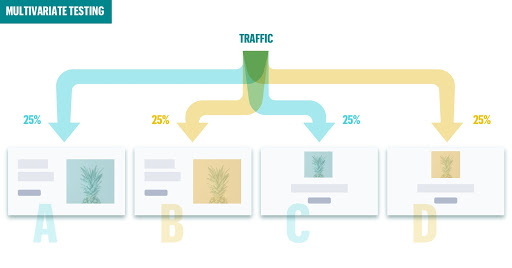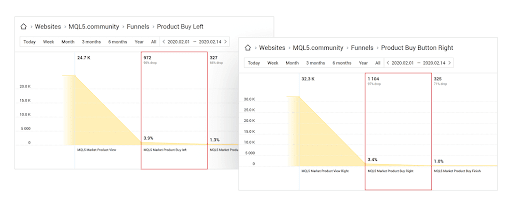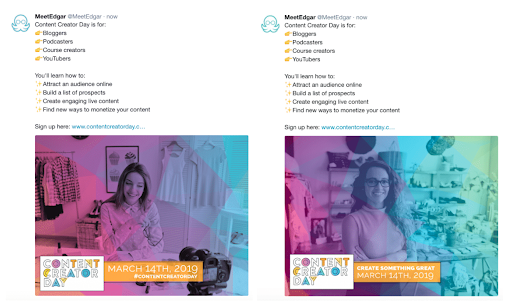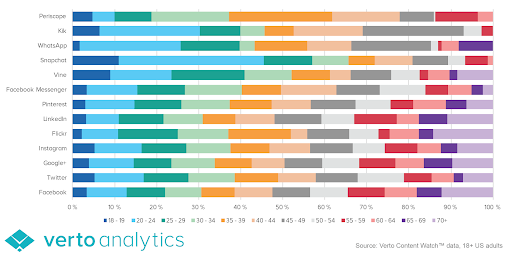30-second summary:
- Less than a quarter of marketers are satisfied with the conversion rates they achieve today.
- A/B and multivariate testing help to put your website’s variables to work, with various text boxes, images, and call-to-actions capable of being tested among different audiences simultaneously.
- Where A/B testing can perform trials of two ideologies, multivariate testing can display a wide range of varied elements to show users exponents are preferred by audiences.
- Multivariate testing can help to optimize web pages based on the traffic arriving from different social networks.
Regardless of whether you’re aiming to foster more leads, email signups or purchases, there are few more effective ways to create more custom than through rigorous testing.
Given the array of tools at the disposal of marketers, just 22% claim that they’re satisfied with the conversion rates that they amass.
Fortunately, A/B testing and multivariate testing can seamlessly combine to fully optimize the process of turning your social media traffic into conversions.
To understand the power of A/B and multivariate testing, it’s important to remember the array of variables that comprise your website. Text boxes, images, videos, call-to-actions and various multimedia plugins all combine to bring audiences an experience that aims to result in a conversion. Testing helps marketers to discover the exact combination of elements that are best placed to encourage visitors to act on the interest that encouraged them to navigate towards your site in the first place. The same practice can apply to just about any marketing approach. From social campaigns to PPC advertising.
For example, have you arranged the images on your website in an effective manner? Or will visitors feel overwhelmed by the overflow of visuals? It’s virtually impossible to anticipate which layout will be the most effective in keeping visitors on your pages for longer – but actively testing different setups can offer up tangible insights into how prospective customers interact with the various elements that comprise your pages.
It’s also possible that different layouts can lead to different effects. If your website’s tone is more informal, you might find that you’ll build more engagement with audiences, but could ultimately lack the sales you were aiming for. Whereas more formal imagery could create more purchasing intent but less of engaging customer experience.
Different businesses will require different levels of website performance, and rigorous multivariate testing helps marketers to see what online features offer varied results for users.
Adopting A/B and multivariate testing tools can help you to generate more leads, a higher volume of subscriptions, and ultimately attract more sales. But let’s take a closer look at how both A/B and multivariate testing can directly boost your social media conversions:
Learning your A/Bs
A/B testing often referred to as split testing, actively compares two versions of a web page, email or other facets of a business in a way that can actively measure their respective performance.
This can be done by rendering one version to be observed by one group and another to a different cross-section of users.
To help illustrate the key concept behind A/B testing, think of yourself as a website owner, and imagine that you have two landing page layouts that you can’t decide on.
Through tools like Unbounce and Optimizely, A/B testing allows you to test one page by showcasing it to one group while sending another to a different group and studying the results. It’s possible to study the performance of each landing page by consulting metrics pertaining to traffic, conversions or purchase intent.
Generally, these metrics will show one landing page to perform better than its competitor and you’ll gain a clear idea of which layout would be most effective online.
Tapping into multivariate testing

Source: Leadpages
While multivariate testing can certainly complement A/B testing, these two practices are not fundamentally the same.
Where A/B testing helps both website owners and marketers to see which design is more popular within different control groups, multivariate testing allows users to test various campaign elements all at the same time.
This means that various different combinations of images, multimedia, text, call-to-actions can all be displayed for different users. While some may be greeted with a large image and a sign-up prompt, others may see an introductory video when they arrive on the same website, for instance.
Given the wide range of element-based combinations that your campaign could feature, multivariate testing is regarded as one of the most efficient ways to gain insights into the impact that your marketing campaign could have once it’s correctly optimized.
Finteza can be a handy tool when it comes to analyzing the performance of A/B tests, enabling you to see which page performs better from a sales funnel point of view.

Advances in marketing technology have catapulted the capabilities of multivariate testing tools into the limelight. With the right software, it’s possible to conduct tests in real-time with the same audience – providing a true sample to draw results from. This means that various combinations of elements can be sent to audiences at different times, with analytical software on hand to interpret the results and figure out which blend of elements operate most efficiently.
The value of A/B testing on social media

Source: MeetEdgar
One of the most effective uses of A/B testing can be found on social media. Campaigns can be optimized for various audiences by sending different messages to different control groups. Where 50% of the control group is shown message A, the other 50% is shown message B. The winning version is determined by which received the highest volume of clicks or impressions. The most effective option is then broadcast to all audiences from there on in.
Social A/B testing helps to enlighten marketers as to which message is most engaging to audiences, and what type of content creates more meaningful engagements. This form of testing can also help to provide insights into what time of day a message will be most likely to hit home and which call-to-actions are best positioned to generate conversions.
A/B testing is best summarized by WIRED writer Brian Christian, who explains that A/B helps to generate high-quality focus-groups that can test new ideas in real-time, without any prior conditioning. “Without being told, a fraction of users are diverted to a slightly different version of a given web page and their behavior compared against the mass of users on the standard site. If the new version proves superior—gaining more clicks, longer visits, more purchases—it will displace the original,” Christian surmised.
The marketing landscape is ever-changing, and very few marketers can seriously claim to have the vision and anticipation required to stay ahead of trends. With this in mind, A/B testing in real-time is essential to gain insights into your target audiences.
While it can seem like a complex approach to conversion optimization, there are plenty of advanced tools that can aid A/B testing methods. Notably tools like Evergage can help to optimize headlines for linked articles on different social media platforms. Content is an essential part of the process of generating new leads, but A/B testing helps marketers to figure out how best to deliver content on different platforms – leading to greater levels of traffic and subsequent conversions.
Multivariate optimization
While A/B testing can work wonders in helping marketers to decide between two different campaign ideas using quantifiable metrics, multivariate testing can deliver more comprehensive and exponential insights.
Of course, social media is a rigid place for the testing of different messages and campaigns, but multivariate testing tools have the power to deliver fully customized website experiences for traffic arriving from various social sources. This can be a particularly effective way of catering to the different demographics of social networks – from the relative maturity of the microblogging platform, Twitter, to the more vivacious and vibrant youthfulness of Snapchat and TikTok.

Source: Online Sales Guide Tips
Given the vast array of elements that can be altered during multivariate testing, it’s important to turn to a tool that can make the whole process of tweaking landing pages and content as simple as possible.
VWO is an effective platform in undertaking not only multivariate tests but also A/B and split URL testing. With the help of visual editors, marketers and website owners alike can change elements on the pages they wish to test and deploy different landing pages for visitors arriving from different places across the web. Furthermore, the tool helps users to study metrics based on how long a visitor spends on pages, how far they scroll, their exit intent and a host of other custom triggers.
The marketing landscape is ever-developing due to the arrival of more intricate and engaging technology. While A/B testing has existed in the world of marketing for some time, multivariate approaches can bring unprecedented levels of optimization and insight into the performance of different ideas and concepts.
For better or worse, the world is in love with social media. But different platforms have evolved to be favored by different user bases. Advanced tools and testing methods can now provide brands with the agility to take on competitors on different social fronts by crafting heavily tested, personalized experiences depending on where their traffic is coming from. The World Wide Web is developing into an increasingly competitive place – advanced testing helps to give conscientious marketers a fighting chance.
Peter Jobes is the Content Marketing Manager at Solvid, a digital marketing agency that specializes in SEO, paid advertising, and website designing.



